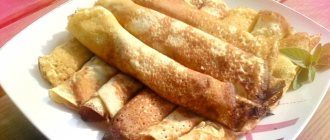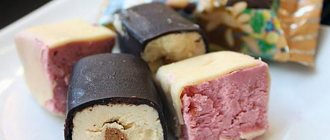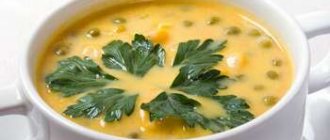Calorie content, nutritional value
The calorie content of pancakes can vary depending on how they are prepared:
| Cooking method | Calorie content of 100 grams of product, kcal | Calorie content of one pancake |
| With milk | 220 | 99 |
| On kefir | 194 | 87 |
| On mineral water | 105 | 47 |
| On the water | 135 | 61 |
| On beer | 164 | 73 |
| On serum | 131 | 59 |
Another indicator that affects the number of calories in pancakes is the filling. The most high-calorie foods are those that contain meat:
| Type of filling | Calorie content of 100 g of product, kcal | Calorie content of one pancake |
| Ground beef | 260 | 117 |
| Chicken mince | 165-265 | 75-119 |
| Minced beef and pork | 270 | 117 |
| Minced pork | 300-490 | 135-220 |
| Chicken meat and mushrooms | 241 | 108 |
| Ham and cheese | 382 | 172 |
| Sausage with cheese | 370 | 166 |
| Liver | 170 | 198 |
| Meat with rice | 250 | 113 |
In cooking, vegetable fillings based on fruits, fruits, berries or their processed products are widely used:
| Type of filling | Calorie content of 100 g of product, kcal | Calorie content of one pancake |
| Baked apples | 254 | 114 |
| Jam | 185-245 | 83-110 |
| Raisin | 228 | 103 |
| Banana with chocolate | 215,9 | 97 |
Other common varieties of plant-based pancake fillings include the following:
| Type of filling | Calorie content of 100 g of product, kcal | Calorie content of one pancake |
| Potato | 170 | 77 |
| Beet | 170 | 77 |
| Zucchini | 139 | 63 |
| Mushrooms | 218–220 | 98–99 |
| Cabbage | 117–147 | 53–66 |
Other types of fillings and their calorie content are presented in the table:
| Type of filling | Calorie content of 100 g of product, kcal | Calorie content of one pancake |
| Cottage cheese with sour cream | 312 | 140 |
| Cheese | 348 | 157 |
| Red caviar | 324 | 143 |
| Fish (salmon) | 313 | 140 |
| Eggs | 222 | 100 |
| Honey | 350 | 158 |
| Butter and sugar | 332 | 149 |
| Condensed milk | 206 | 93 |
| Sour cream | 311 | 140 |
Another factor that affects the number of calories is the flour used in cooking. The content of proteins, fats and carbohydrates in the product also depends on this. The most commonly used types are:
| Flour | Calorie content of 100 g of product, kcal | Calorie content of one pancake | BJU per 100 g of product |
| Wheat | 89 | 196,6 | 5,4/6,6/29,3 |
| Buckwheat | 59 | 131,3 | 4,9/1,1/24,8 |
| Oatmeal | 64 | 142,2 | 4,9/5,2/18,8 |
| Rice | 75 | 166 | 4,2/4,9/25,6 |
| Linen | 51 | 114,4 | 13,1/2,7/10 |
| Soy | 42 | 93,8 | 8,5/4,5/4,4 |
| Corn | 70 | 157 | 4,1/1,5/31,5 |
Other types of pancake flour used in cooking include:
| Flour | Calorie content of 100 g of product, kcal | Calorie content of one pancake | BJU per 100 g of product |
| Rye | 75 | 166,5 | 5,7/4,9/25,8 |
| Chickpeas | 64 | 141,6 | 5,4/5,5/17,1 |
| Coconut | 114 | 254 | 9,3/7,2/38,6 |
| Pea | 56 | 126 | 22/15/63 |
| Amaranth | 50 | 112,4 | 5/3/15,9 |
Historical reference
Many people believe that pancakes are an original Russian dish. However, in fact, the ancient Egyptians were the first to make sour flatbreads in the fifth century BC.
In Rus', the first pancakes made from yeast dough appeared around 1005-1006. There are several legends about how exactly the first pancake was “born”. So, according to one version, the housewife simply forgot oatmeal jelly in the oven. It thickened, fried, and, after “taking a sample,” everyone decided that it turned out very tasty.
It is noteworthy that from the very beginning, pancakes were a dish for the preparation of which only extremely high-quality products were traditionally used. This was due to the fact that they were endowed with sacred meaning - they, like kutya, were intended to commemorate deceased relatives. According to tradition, they were baked after the funeral and distributed to the poor with a request to remember the newly deceased.
Content:
- Historical reference
- Curious facts
- Interesting traditions
- Composition and calorie content of pancakes
- The benefits and harms of pancakes
- Thin pancakes with milk
- Pancakes on kefir with boiling water
- Zucchini pancakes
However, over time, the meaning of this dish has changed. They turned into the main dish of Maslenitsa - the holiday of farewell to winter. The golden round pancake began to be seen as a symbol of the spring sun and the Slavic deity Yarilo. Each housewife had her own secret recipe, which was passed down from mother to daughter. Those who did not have the opportunity to bake the treat themselves could buy it from street vendors - fortunately, on Maslenitsa this food was sold literally “on every corner”: in taverns or from peddlers right on the streets.
The fillings were very varied - sour cream, honey, mushrooms, caviar or fish. Those who had more modest incomes were content with pancakes stuffed with millet or buckwheat.
The so-called “pancakes with seasoning” were considered a special delicacy. They were prepared in a special way - they were fried on one side, and any filling was put on the other and the dough was poured on top. Then the baked goods were turned over to the other side and fried. The result was a double pancake with a “hot” filling in the middle. These baked goods were filled with fresh wild mushrooms, herbs, vegetables, and boiled eggs.
Composition and properties
The content of chemical elements and vitamins in pancakes varies depending on the recipe, but in most cases the following ingredients can be found in the product:
- vitamins A, group B (B12, etc.), D, E, K;
- calcium;
- iron;
- magnesium;
- zinc;
- amino acids;
- fats;
- cholesterol;
- proteins;
- cellulose.
The content of the above substances is due to the use of the most common products in preparation - flour, eggs and milk.
The main positive properties of pancakes include:
- strengthening the skeletal system;
- restoration of normal functioning of the cardiovascular system;
- prevention of diabetes development;
- decreased stomach acidity;
- normalization of the functioning of the gastrointestinal tract, improvement of intestinal motility;
- saturating the body with energy, giving strength;
- reducing the risk of developing anemia;
- normalization of the central nervous and muscular systems;
- improvement and restoration of vision;
- support of metabolic processes.
Interesting traditions
Not only the baking of pancakes, but also their consumption was associated with a huge number of traditions. So, they were allowed to be taken exclusively with their hands. No cutlery could be used, and a person who cut a pancake with a knife was considered a real criminal in Rus'!
Abroad, pancakes are prepared from almost the same products, but each nationality has its own characteristics associated with their baking and consumption. So, in the UK, ale and malt flour are used for pancake dough. American pancakes are small in size and very plump. In fact, these are pancakes that are served in a heap, with a layer of maple syrup, cottage cheese, berries or vegetables. The Germans serve lemon and sugar with their pancakes, while the Spaniards bake them from corn flour and stuff them with minced meat. And in China they add a huge amount of onions to the dough.
Today in the world, in addition to ordinary Russian pancakes, French crêpes folded into “envelopes”, incredibly tender Czech “palachinki” with vanilla or cheese sauce, American pancakes, the Mongolian version of pancakes called gambir, as well as Ethiopian pancakes from teff flour called "injera".
Use in weight loss
Pancakes are high-calorie foods, the consumption of which is undesirable when losing weight. However, if certain requirements are met, their use is permissible even on a diet:
- Do not use sunflower oil for cooking; use a non-stick frying pan.
- Instead of milk, take kefir, mineral or ordinary water.
- Rice, buckwheat, corn, etc. should be preferred to high-calorie wheat flour.
- Use only fermented milk types of sour cream and cream with a low fat content.
- Cook only thin pancakes that weigh about 45 g.
- Do not butter every product.
- Add only chicken whites (90% water) to the dish and try not to use yolks.
- Take fruits, berries, fruits as filling.
- Instead of sugar, use honey or a sweetener.
It is recommended to eat pancakes in the morning; you should refrain from eating them in the evening. It is necessary to follow the norm and not overeat even if there are no problems with excess weight. It is enough for women to eat 3-4 pancakes, and for men – 4-5.
Curious facts

It would seem that we know everything about pancakes. However, there are several interesting facts that probably remain unknown to a wider audience.
Housewives are now baking pancakes from wheat flour. In Rus', buckwheat flour has long been considered pancake flour. Thanks to her, the dough turned out to be very aromatic, and the baked goods had a pleasant, slightly sour taste.
The dough was kneaded with yeast, with the addition of milk and water. As a result, the pancakes turned out loose and very fluffy.
For baking, a stove was used, which was heated with small birch firewood specially prepared for this purpose. To ensure that the pancake was evenly baked, a special, very bulky design was used - cast iron frying pans welded together. They were first sprinkled with salt, thoroughly calcined, then wiped with a cloth and greased with lard.
The well-known proverb “the first pancake is lumpy” has nothing to do with the mistakes of ancient culinary specialists. In fact, it is associated with the Komoeditsa holiday, the main characters of which were... bears. These animals were called “comas” in Rus'. Komoeditsa was timed to coincide with the awakening of animals after winter hibernation, and pancakes were brought “as a gift” to the bears in their den in the early morning. This is exactly how the proverb “The first pancake is comAm” arose, which over time was transformed and acquired its modern meaning.
Pancakes
Pancakes are a flour dish made from liquid unleavened or yeast dough, fried on both sides in a frying pan with added fat. Traditional pancakes are round, in the form of thin flat cakes, of uneven color. Thickness, taste, size, shape (there are square pancakes) and color depend entirely on the original ingredients, habits and imagination of the housewife. Openwork yeast pancakes, smooth pancakes using soda or baking powder are favorite culinary products of many generations.
During pagan times, the Slavs baked pancakes as a symbol of the Sun, as evidenced by the Maslenitsa holiday, which is still revered and celebrated with pleasure. Pancakes and pancakes are present in many cuisines of the world, in France they bake the finest crepes, in Mongolia - gambier, in England they prepare pancakes. A mandatory ingredient in any pancakes is flour - wheat, oatmeal, buckwheat or any other.
Pancakes on kefir with boiling water
Many housewives use kefir rather than milk to make pancakes. The pancakes end up being thin, porous, and they literally melt in your mouth.
You will need: kefir (400 l), boiling water (200 ml), two eggs, 250 g of flour, two tablespoons of sunflower oil, 75 g of sugar, half a teaspoon of soda and literally a pinch of salt.
Eggs should be thoroughly beaten with sugar and salt. Pour kefir into the same container, add pre-sifted flour and beat again.
Best materials of the month
- Coronaviruses: SARS-CoV-2 (COVID-19)
- Antibiotics for the prevention and treatment of COVID-19: how effective are they?
- The most common "office" diseases
- Does vodka kill coronavirus?
- How to stay alive on our roads?
Boil water, dissolve soda in it and begin pouring it into the dough in a thin stream, stirring constantly. After this, add a tablespoon of vegetable oil and let the dough sit for about five minutes.
Heat the pan well. Grease it with vegetable oil and start frying pancakes.
The benefits and harms of pancakes
The benefits of pancakes are determined by the chemical composition of these baked goods. It contains B vitamins (a positive effect on metabolism, normalization of the immune system), (a powerful antioxidant that affects the functioning of the reproductive system and skin condition) and (lowering cholesterol levels, stimulating the gastrointestinal tract). Also contains potassium (strengthening the heart muscle), sodium (normalizing kidney function), magnesium (cell regeneration, removal of toxins), iron (preventing anemia and thyroid diseases) and phosphorus (responsible for the condition of bones and teeth, promotes mental activity) .
At the same time, pancakes, especially with fillings, are quite high in calories, and therefore people who are prone to gaining extra pounds should not get too carried away with this dish.
In addition, ready-made pancakes are now sold in many supermarkets, but the quality of such baked goods leaves much to be desired due to the huge amount of flavorings and preservatives that unscrupulous manufacturers add to them. Therefore, if you still decide to enjoy pancakes, it is better to bake them yourself.









